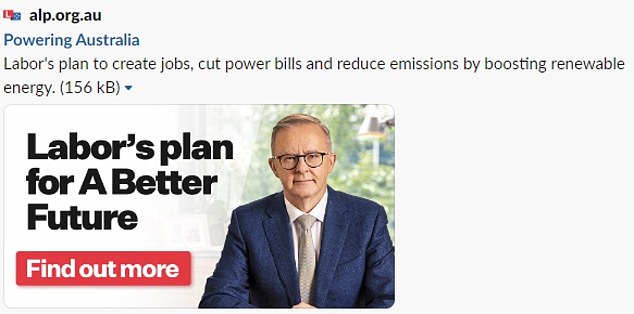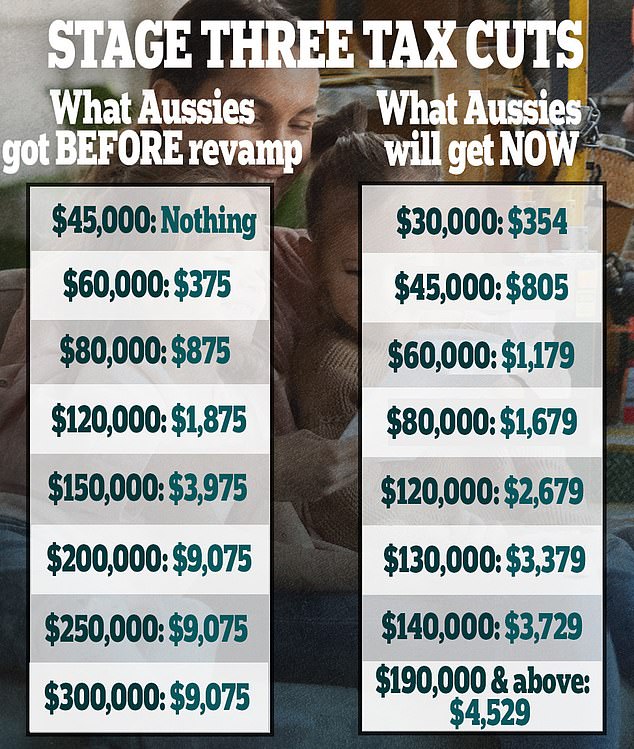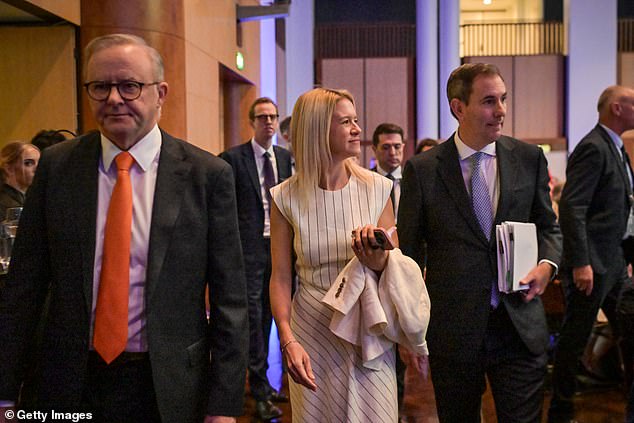A $300 electricity bill rebate for everyone, regardless of income, has created a ticking time bomb for the Labor Party.
This rebate only lasts one year, raising concerns that inflation will rise again once it ends in June 2025, or even fail to reduce inflation as promised.
Then there are also concerns about higher budget deficits, starting next financial year, as a result of rising costs of the National Disability Insurance Scheme and falling commodity prices.
Prime Minister Anthony Albanese won the 2022 election after promising to reduce average annual electricity bills by $275 by 2025.
The $300 electricity bill refund has created a ticking time bomb for the Labor Party. Pictured are Prime Minister Anthony Albanese (; left), Treasurer Jim Chalmers (right) and his wife Laura.
Late Tuesday, Treasurer Jim Chalmers announced a new $300 non-means-tested rebate at a cost of $3.5 billion.
It expires in June 2025, at which time elections would have been held.
The Treasury also promised in the Budget that headline inflation, now at 3.6 per cent, would fall to 2.75 per cent by December 2024, creating another potential broken promise trap should inflation not moderate as a result. of this refund.
The Reserve Bank of Australia does not expect the consumer price index to fall to 2.8 per cent until the end of 2025.
It also expects inflation to rise to 3.8 percent by June 2024 before there is improvement.
So even if the Treasury forecasts a half a percentage point drop in inflation in 2024/25, as a result of this $300 energy rebate, the risks are that inflation could still be above the 2 to 3 per cent target from the RBA by the end of this year.
Despite the risks of a potentially broken promise, Dr. Chalmers has continued to insist that the $300 rebate would reduce inflation.
“Our budget will put downward pressure on inflation, not upward pressure on inflation, and that’s important because we’ve made good progress,” he told ABC Radio National on Wednesday morning.
Before the last election, the Australian Energy Market Operator noted that annual wholesale prices had more than doubled to $87 in the March quarter, rising 141 per cent in a year.
Wholesale prices account for around a third of the energy bill, giving Labor a platform in opposition to campaign on the cost of living crisis.

Prime Minister Anthony Albanese won the 2022 election after promising to reduce average annual electricity bills by $275 by 2025.
Once in government, the Treasury predicted at the end of 2022 that energy bills would rise by 56 percent over two years.
The Labor Party panicked and removed its election promise from its website at the end of 2022, only to reinstate it after a Daily Mail Australia story.
Dr Chalmers responded in the May 2023 budget by announcing a $500 Energy Bill Relief Fund, co-funded by the Commonwealth and the states.
This plan, which expires in June 2025, was restricted to pensioners, caregivers and health card holders, unlike the last $300 refund.
Despite the policy, electricity bills continued to rise at an annual rate of 15.7 percent in 2023.
Inflation is expected to moderate even as 13.6 million Australians, including 2.9 million minimum wage or part-time workers, receive relief from the revised stage three tax cut, which will cost $1.3 billion over five years .
Deficits in future years
On Budget night, Dr Chalmers took pride in having become the first treasurer since 2007 to achieve a second consecutive budget surplus, and the first at federal level for the Labor Party since 1989.
Treasury Budget documents showed a record surplus of $12.1 billion for 2022-23, followed by a surplus of $9.3 billion for 2023-24.
But after that, a series of deficits are forecast, starting with $28.3 billion in 2024-25 and reaching $42.8 billion in 2025-26, representing 1.5 percent of gross domestic product.

Over four years (through 2027-28), projected budget deficits total $122 billion.
Economist Chris Richardson, a partner at Deloitte Access Economics, noted that Tuesday night’s budget had $9.5 billion in new spending for next year.
“The government said it would not bring things forward, that it would be careful not to upset the inflationary bear, that it would put it in the back – they absolutely have it in the front,” he said.
The cost of the National Disability Insurance Scheme was estimated to rise by $11.1 billion over four years, from 2023-24 to 2026-27.
The NDIS was forecast to cost $48.752 billion in 2024-25 and rise to $60.746 billion in 2026-27, making it the third most expensive program after funding for states and territories and seniors.
Then there is the drop in corporate tax revenues due to falling commodity prices, with iron ore prices falling to just $60 a tonne in March 2025 (less than $117 now), while that thermal coal prices fell to $70 per ton (previously $140 per ton). ton in early 2024.
A drop in key raw material prices means the government takes less tax revenue from companies, and every $10 per tonne drop in iron ore prices will reduce tax revenue by 500 million dollars a year.
The Treasury warned that a slowdown in China’s housing market would lead to a decline in its demand for Australian iron ore, the commodity used to make steel.
“Demand from the real estate sector is expected to remain weak, as residential construction starts in China have fallen to their lowest level in more than 15 years, steel production is likely past its peak and is expected to decline in 2024,” he said.

